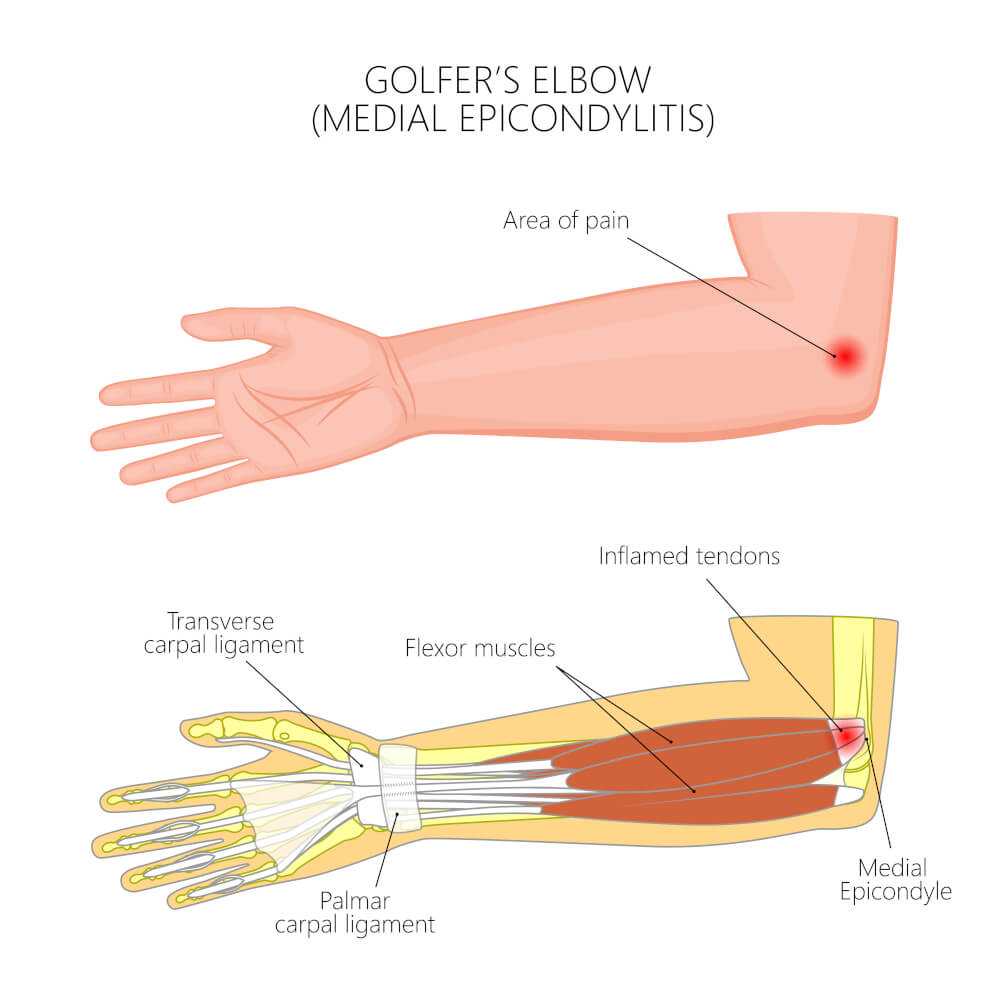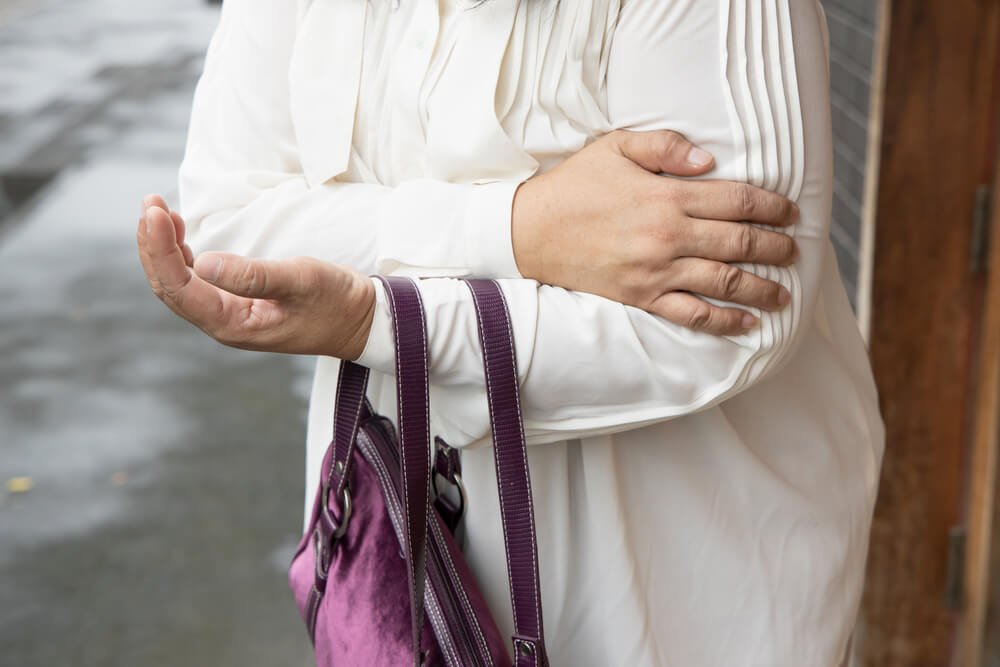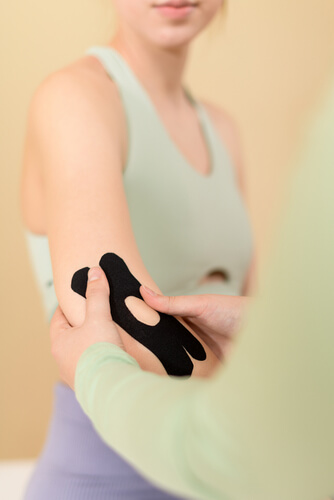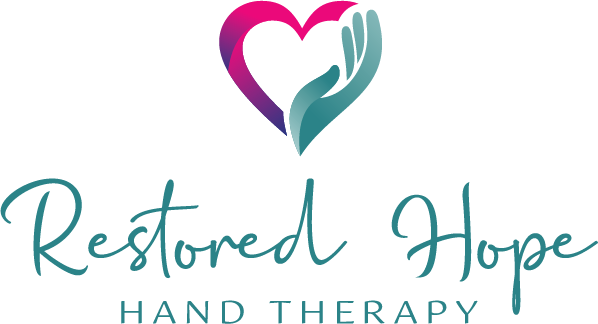Golfer's Elbow
Home » Treatment » Arm & Elbow » Golfer’s Elbow
What is Golfer's Elbow?
Although its name suggests a connection to golf, this condition can affect anyone who repeatedly uses their forearm muscles, such as golfers, tennis players, and individuals involved in activities that require gripping, lifting, or throwing.
Golfer’s elbow, medically known as medial epicondylitis, is a condition that affects the tendons and muscles on the inner side of the forearm near the elbow. It is similar to tennis elbow, but it occurs on the inner side of the elbow, while tennis elbow affects the outer side.
Golfer’s elbow is typically caused by overuse or repetitive stress on the wrist and forearm muscles and tendons that attach to the bony bump on the inner side of the elbow (medial epicondyle). These repetitive motions can lead to small tears in the tendons, which can result in pain and inflammation. Despite the name “golfer’s elbow,” this condition can affect anyone who performs activities that involve repetitive gripping, wrist flexion, and forearm rotation.
If you have a question about whether your condition should be treated by one of our hand therapists, call Restored Hope Hand Therapy at (928) 275-2201.

Causes of Golfer’s Elbow
There are several common causes and risk factors that can lead to the development of golfer’s elbow, including:
- Repetitive gripping and twisting: Activities that involve repeated gripping and twisting of the wrist and forearm can strain the tendons and muscles, leading to golfer’s elbow. This can occur in sports like golf, tennis, and racquetball, as well as in various occupational tasks such as carpentry, plumbing, or painting.
- Incorrect technique: Using improper technique when performing repetitive forearm movements can put excessive stress on the tendons and muscles. For example, a golfer with a poor swing or a tennis player with improper backhand technique may be more prone to developing golfer’s elbow.
- Overexertion: Overexerting or using too much force during activities that involve wrist flexion or forearm rotation can contribute to the development of golfer’s elbow. This often occurs in sports or activities where power and control are required.
- Inadequate warm-up and stretching: Failing to warm up properly or neglecting to stretch the wrist and forearm muscles before engaging in physical activities can increase the risk of injury, as cold muscles and tendons are more susceptible to strain.
- Age and gender: Golfer’s elbow can affect people of all ages, but it is more common in individuals between the ages of 40 and 60. Additionally, men are more prone to developing golfer’s elbow than women.
- Pre-existing conditions: Certain medical conditions, such as arthritis or diabetes, can weaken the tendons and muscles, making them more susceptible to injury.
- Poor equipment fit: Ill-fitting sports equipment, like golf clubs, tennis rackets, or tools, can cause an imbalance in the distribution of forces, leading to increased strain on the forearm.
- Repetitive computer mouse use: People who use a computer mouse for extended periods with improper hand and wrist positioning may develop golfer’s elbow due to the repetitive strain on the forearm muscles.
- Direct trauma: In some cases, a direct blow to the inner side of the elbow can cause acute injury to the tendons and muscles, leading to golfer’s elbow.
How Does it Feel?
Common symptoms of golfer’s elbow may include:
- Elbow pain: Persistent pain and tenderness on the inner side of the elbow, near the bony bump called the medial epicondyle. The pain may radiate down the forearm.
- Weakness: Weakening of the forearm muscles, leading to difficulty with activities that involve gripping or flexing the wrist.
- Stiffness and limited range of motion: Reduced elbow joint flexibility makes it challenging to bend or straighten the arm fully.
- Pain aggravation: Pain may worsen with specific movements, such as flexing the wrist or gripping objects.
- Pain with common actions: Activities that involve wrist flexion or gripping, such as swinging a golf club, can exacerbate the pain.

How Is It Diagnosed?
Your hand therapist at Restored Hope Hand Therapy will perform a thorough evaluation. They will ask you questions about any pain or other symptoms you may have, and may:
- Perform strength and motion tests on your wrist, forearm, and elbow.
- Ask about your job duties and hobbies.
- Evaluate your posture.
- Check for any muscle imbalances and weakness that can occur along the path from your shoulder blade to your hand.
- Gently touch your elbow in specific areas to find out which tendon or tendons may be inflamed.
- Conduct special muscle tests as needed, such as bending the wrist or rotating the forearm with resistance to confirm a diagnosis.
Treatment
It is crucial to treat golfer’s elbow as early as possible to prevent the condition from becoming chronic. Elbow therapy provides timely and effective treatment to reduce pain, restore function and strength to the elbow, forearm, and wrist, and address body mechanics to prevent the condition from recurring.
Pain management: Rest from aggravating movements to allow the tendon to heal; use of ice, heat, ultrasound, bracing and splinting to reduce pain.
- Manual therapy: Use of soft tissue and joint mobilization techniques to regain full movement in the affected area; stretching of the elbow, forearm, wrist, shoulder, and thoracic spine.
- Strengthening exercises: Targeted strengthening exercises of the forearm, elbow, and hand incorporating resistance exercises using weights and resistance bands to address muscle weaknesses and imbalances.
- Isometric exercises: These exercises can be used during the acute phase of golfer’s elbow. Isometric exercises generate force without changing the length of the muscle.
- Eccentric exercises: These exercises cause muscles to elongate in response to a greater opposing force and build muscle flexibility. Eccentric exercises strengthen muscles, tendons, and ligaments and can help reduce the risk of muscle strains and tears. Eccentric exercise, a progressive loading program on the tendon, helps the tendon gradually adapt to tolerate the demands placed on it.
- Patient education and functional training: Modifying specific movement patterns to lessen the stress on the tendons, forearm, elbow, and wrist and reduce risk of injury, such as adjusting your golf swing and throwing techniques or altering work tasks to reduce the pressure placed on the tendons of the forearm.
Preventing Golfer's Elbow
Understanding the risk of injury and being aware of your daily movements can help prevent medial epicondylitis. Individuals should:
- Use proper form and technique when doing repetitive work tasks or sports movements, like golf swings.
- Maintain shoulder, forearm, and wrist muscle strength.
- Perform gentle forearm muscle stretches before and after performing tasks.
- Use proper posture and body mechanics when lifting heavy objects to reduce joint strain.
Preventing golfer’s elbow involves proper technique and equipment use in activities that involve repetitive arm and wrist motions. If you suspect you have golfer’s elbow or experience persistent elbow pain, it’s essential to seek medical advice for a proper diagnosis and treatment plan at Restored Hope Hand Therapy.
Arm & Elbow Therapy Options
individualized-specific therapy programs to offer you the best possible results.
Arm & Elbow
- Capitellum Injuries
- Distal Biceps Tendon Injuries
- Elbow Dislocations
- Elbow Fractures
- Golfer's Elbow
- Ligament Sprains or Tears
- Little League Elbow Syndrome
- Olecranon (Elbow) Bursitis
- Osteoarthritis
- Radial Head Injuries
- Sprains & Strains
- Tendonitis
- Tennis Elbow
- Ulnar Collateral Ligament Injuries

 Pain management: Rest from aggravating movements to allow the tendon to heal; use of ice, heat, ultrasound, bracing and splinting to reduce pain.
Pain management: Rest from aggravating movements to allow the tendon to heal; use of ice, heat, ultrasound, bracing and splinting to reduce pain.